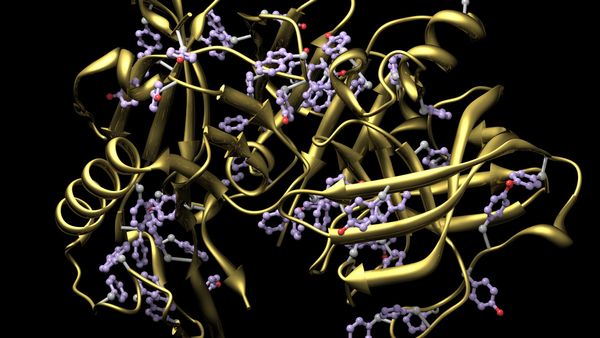
For decades, scientists have been trying to develop therapeutics for people living with Alzheimer’s disease, a progressive neurodegenerative disease that is characterized by cognitive decline. Given the global rise in cases, the stakes are high. A study published in The Lancet Public Health reports that the number of adults living with dementia worldwide is expected to nearly triple, to 153 million in 2050. Alzheimer’s disease is a dominant form of dementia, representing 60 to 70 percent of cases.
Recent approvals by the Food and Drug Administration have focused on medications that shrink the sticky brain deposits of a protein called amyloid beta. The errant growth of this protein is responsible for triggering an increase in tangled threads of another protein called tau and the development of Alzheimer’s disease — at least according to the dominant amyloid cascade hypothesis, which was first proposed in 1991.
Over the past few years, however, data and drugs associated with the hypothesis have been mired in various controversies relating to data integrity, regulatory approval, and drug safety. Nevertheless, the hypothesis still dominates research and drug development. According to Science, in fiscal year 2021 to 2022, the National Institutes of Health spent some $1.6 billion on projects that mention amyloids, about 50 percent of the agency’s overall Alzheimer’s funding. And a close look at the data for recently approved drugs suggests the hypothesis is not wrong, so much as incomplete.
A few years ago, Matthew Schrag, a neurologist at Vanderbilt University, discovered possible image tampering in papers that supported the hypothesis, including in an influential 2006 Nature study that was eventually retracted. At roughly the same time, the FDA had been greenlighting medications that target amyloid beta.
In June 2021, the Food and Drug Administration approved aducanumab, an amyloid beta-targeted drug, under the “accelerated approval” program for patients diagnosed with Alzheimer’s. This pathway allows conditional authorization of drugs for serious and life-threatening diseases if there are few if any treatment options available, and if the drug affects a surrogate endpoint, something measurable in the body — in this case amyloid plaque build-up — in a way considered reasonably likely to reduce or prevent symptoms.
The data supporting aducanumab’s use were incomplete and contradictory, and approximately 40 percent of clinical trial participants suffered brain swelling or bleeding. Notably, the FDA ignored advice given by an independent advisory committee in its decision to approve the therapeutic. Schrag publicly criticized the move; meanwhile, The New York Times reported that three experts resigned from the advisory committee. They were troubled by the FDA going against a near-unanimous vote by the committee. The FDA was further criticized for not providing a compelling justification for its decision.
Prompted by the aducanumab controversy and inconclusive evidence on safety and efficacy, the Centers for Medicare and Medicaid Services, whose mandate is to determine whether to reimburse medical products, took the unusual step of conducting an analysis of the clinical data regarding aducanumab and other monoclonal antibodies that were being developed for treatment of Alzheimer’s at the time.
CMS covers products that it deems are “reasonable and necessary,” which means safe and effective, not experimental, and appropriate for Medicare patients. The agency leaves most coverage decisions up to individual health plans that contract with CMS. But in a small number of instances in which there’s a high degree of uncertainty surrounding a medical technology’s safety and efficacy, CMS carries out a national coverage determination. Subsequent to its analysis, CMS posted an official notice which stated that Medicare reimbursement would be mostly limited to Alzheimer’s antibodies that had been granted regular, as opposed to accelerated, approval. And beneficiaries requesting access to regularly approved Alzheimer’s antibodies must enroll in post-marketing patient registries that gather additional data.
Over the past few years, data and drugs associated with the amyloid hypothesis have been mired in various controversies relating to data integrity, regulatory approval, and drug safety.
The next drug to be approved was lecanemab, which also targets amyloid beta. It received accelerated approval in January 2023; later that year, it received a regular approval, which paved the way for CMS reimbursement. This time, there wasn’t a regulatory controversy. Lecanemab demonstrated modest cognitive benefit in patients with early Alzheimer’s disease. Nevertheless, trial participants were exposed to a moderate risk of brain swelling and bleeding and a few died. Questions related to lecanemab’s safety profile led to a quarrel among researchers about the risks associated with its use.
And even though the data demonstrated modest benefit in research settings, it’s unknown whether the observed lessening of cognitive decline provides clinically meaningfully improvement for patients in the real world. Experts expressed both optimism and caution.
In July 2024, the FDA approved a third antibody for Alzheimer’s. Unlike the previous two approvals, this new therapeutic, named donanemab, targets amyloid beta only at a later stage when it has clumped together to form plaques. It offers similar efficacy to lecanemab and comparable safety risks.
To Eric Widera, a professor of medicine at the University of California, San Francisco, the “results of the lecanemab and donanemab trials highlight the complexity of Alzheimer disease itself.” The drugs’ ability to remove amyloid, paired with their slight effect on measures of cognition, suggest that amyloid is likely a factor — but not the only factor contributing to Alzheimer disease progression, he wrote in an email to Undark.
Donald Weaver, a clinical neurologist at Toronto Western Hospital and a professor of medicine at the University of Toronto, agrees that the modest efficacy of some amyloid-targeting drugs does lend validity to the dominant hypothesis, “but by no means is amyloid the whole story,” he wrote in an email to Undark.
Based on findings from his own research, Weaver noted in an article in The Conversation, he believes that amyloid beta is a “normally occurring molecule that is part of the brain’s immune system.” But in the event of an infection or other trauma, the amyloid beta can’t distinguish between the invading pathogens and the host brain cells, and it may end up attacking both. This in turn leads to a chronic, progressive loss of brain cell function and ultimately, dementia.
Another line of research, which also highlights the immune system, doesn’t attribute any protective property to amyloid. Rather, the brain’s immune response contributes to neuroinflammation and increased accretion of amyloid and tau, which in turn leads to neurodegeneration.
To tackle presumably harmful neuroinflammation and protein build-up, scientists at the University of Texas Health Science Center at San Antonio are currently investigating the therapeutic effects of the antiretroviral HIV medication, lamivudine, which may reduce tau clumping and brain inflammation. This follows a large-scale observational study examining the effects of the class of drugs that lamivudine belongs to, which showed lower rates of Alzheimer’s disease in people with HIV taking the drug.
Separately, researchers are conducting a study at the Amsterdam University Medical Center involving a different HIV medicine, efavirenz. This line of inquiry follows animal model and stem cell studies in which efavirenz reduced the accumulation of both amyloid beta and tau. It’s hypothesized that accumulation of cholesterol in the brain cells of Alzheimer's patients directly leads to the formation of tangles of tau and amyloid plaques. Efavirenz may reduce brain cholesterol.
"By no means is amyloid the whole story."
And finally, researchers at Arizona State University and Banner Alzheimer’s Institute published a study in December that investigates a possible link between a common herpes virus and Alzheimer’s disease. In some people who develop a chronic gut infection from the virus, the pathogen may travel to the brain via the vagus nerve which connects the gut and brain. There, it can alter the neuroimmune system, which in turn triggers changes implicated in the development of Alzheimer’s, including inflammation and amyloid beta and tau clumping. If the connection between the virus and Alzheimer’s is proven, antivirals could then be used to potentially treat the disease.
As all these new studies unfold, additional pieces of the Alzheimer’s puzzle may be found, together with how they relate to one another, perhaps mediated by our immune systems. Ultimately, tackling Alzheimer’s successfully will likely involve a multi-pronged approach that targets multiple causes, including amyloid and tau build-up.
This article was originally published on Undark. Read the original article.











